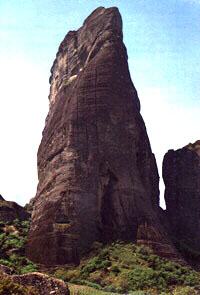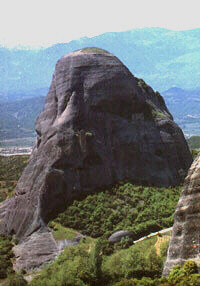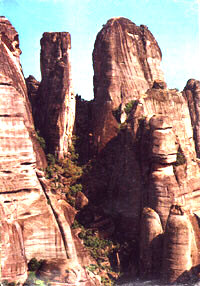Required Climbing Experience and Equipment | Routes
Mountaineering in Meteora
| Driving through Trikala up to Kalabaka, the flat plain gives way to a valley dominated by a cluster of towering pillars of rock, some of which rise to 250m. The tops of these pillars were originally inaccessible except to climbers equipped with ropes and ladders, and the first people who dared to scale them were religious hermits seeking to withdraw from a fallen world. From the ninth century monasteries were built, often lifting people and goods up to the tops by means of rope baskets and pulley systems. At one time as many as 20 monasteries were occupied, but now only five remain, usually with only a few monks or nuns to look after the place. Nowadays the monasteries are more like museums, or exhibits in a theme park than places of religious retreat, and the tour busses that wind their way along the road circling the rocks dispel the otherworldly quality that the area must once have had. The approach to the remaining monasteries has been made easier by steps cut into the rock. Despite this, the area is still a feast for the imagination as well as offering some amazing and quite distinctive climbing. Rocks and climbing The first people to begin developing modern climbing in the area were Dietrich Hasse and Heinz Lothaz Stutte, who first visited Meteora in 1975. Over the following years the pair set up routes on all of the 80 rocks, except the 5 which have working monasteries. The two have also produced two excellent guides to the area: "Meteora a Landscape to be Experienced," and the "Meteora Climbing and Hiking Guide." The rocks are an aggregate of pebbles, of varying sizes, and sandstone. Climbing in the area requires a careful choice of which pebbles to use as pinch grips and footholds. With little opportunity for routes requiring big arms, all that is usually called for is judgement and balance. Loose pebbles and crumbly sandstone can sometimes be a problem but on the more popular routes most of the loose pebbles have already popped. There are no cracks to climb, and so there is also little opportunity for placing your own protection with nuts and hexentrics. Generally you have to rely on the pre-placed bolts, although the distance between these can sometimes feel a little excessive. It cannot be emphasized enough that anybody wanting to climb the Meteora rock towers, the majority of which are very difficult to tackle, will need a great deal of rock climbing experience and sound equipment. Any attempts to climb the rocks without these essential prerequisites are, as a rule, irresponsible and could even be fatal. Lots of old routes requires free climbing, often over exposed rock. In this kind of routes, one has to be prepared and able to climb freely over distances of ten metres and more corresponding to grade IV or V (UIAA). This old routes have a reasonable minimum of safe-guards in order to make climbing a responsible sporting activity rather than a hazardous game for all those able to tackle the existing difficulties. Standing and abseiling rings as well the intermediate bolts are trustworthy (stainless anchors for climbing 10 - 12 - 16 mm, and chemical-ampoules). As the surface of the rock is smooth and compact, it is unsuitable for attaching normal pitons or other kind of protection. Recommended: respect the ethics and standards of the climbing area. Rock climbers will find about fifty massive towers of rock and approximately eighty peaks worth climbing amongst the four groups found in the central area of Meteora. The extensive wall of Great Saint (Aghia) facing Kalampaka rises to the greatest height - well over 300 meters. Not quite as high are the Alyssos East Face and the north west and north east precipices of the Holly Ghost (Aghion Pnewma, not far from which is the western drop of the Sourloti. The most important peaks are Ftelias in the northern group. Kreni Petra, The Bishop 's Mitre, Kastraki Tower, Ypsilotera Rock, Varlaam Tower and Doupiani Rock in the western group.
| ||||
© Copyright Stefanos Nicologiannis - All rights reserved


